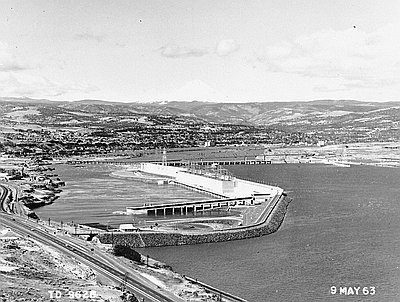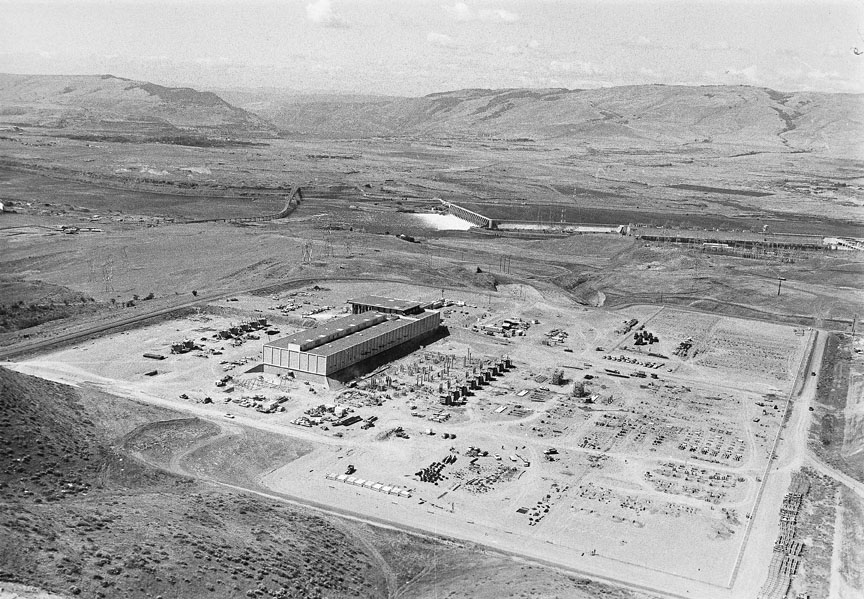- Catalog No. —
- OrHi 81761
- Date —
- August 1968
- Era —
- 1950-1980 (New Economy, Civil Rights, and Environmentalism)
- Themes —
- Environment and Natural Resources, Trade, Business, Industry, and the Economy
- Credits —
- Oregon Historical Society
- Regions —
- Columbia River
- Author —
- Unknown
Celilo Converter Station
Located along the Columbia River, near The Dalles Dam, the Celilo Converter Station is the northern terminus of an 800 kilovolt d-c (direct current) extra-high-voltage transmission line stretching 846 miles south to the Sylmar Converter Station, its counterpart near Los Angeles. Electrical power generated by the Columbia River hydrosystem as a-c (alternating current) power is converted into d-c power at the station, allowing for more economical long-distance energy transfers between the Pacific Northwest and Pacific Southwest. Once the energy reaches Sylmar, the power is converted back to a-c power before being distributed to electrical customers.
Operating as one leg of the Pacific Northwest-Pacific Southwest Intertie, the high voltage d-c transmission line was once the longest of its kind anywhere in the world, helping to create the largest interconnected electrical grid in the United States. Nearly 265 miles of the line was constructed by the Bonneville Power Administration, reaching from the Columbia River southeast through Central Oregon to the Nevada border. The remaining 580 miles of line, passing through western Nevada and then arching southwest to Sylmar near Los Angeles, was built by the city of Los Angeles. Construction of the d-c leg of the Pacific Intertie began in 1966 and lasted until 1970, with the Celilo Converter Station facility itself costing $54 million.
The development of d-c technology and the construction of the Pacific Intertie was looked on closely by many members of Congress and mining interests hoping to capitalize on the availability of power-producing fossil fuels in their own districts and territories. Advocates for reinvigorated coal mining in places like Pennsylvania and West Virginia hoped that d-c transmission would allow for the construction of mine-mouth power plants to supply cities like Philadelphia, New York, and Boston. Similarly, backers of natural gas extraction from the Northern Great Plains hoped they could supply Chicago with power from plants built on top of their gas fields, and Alaskans envisioned large hydropower projects with d-c lines reaching southward into the power grids of Canada and the American West.
Further Reading:
Norwood, Gus. Columbia River Power for the People: A History of Policies of the Bonneville Power Administration. Portland, Oreg., 1981.
Springer, Vera. Power and the Pacific Northwest: A History of the Bonneville Power Administration. Washington D.C., 1976.
Written by Joshua Binus, © Oregon Historical Society, 2004.
Related Historical Records
-
The Dalles Dam
This 1963 photograph of The Dalles Dam was published in the March 1968 edition of the Portland Chamber of Commerce’s monthly magazine, Greater Portland Commerce. The accompanying article, …

-
The Electric Century: The Promise of Technology
The Lewis and Clark Exposition at night was a blaze of light. One hundred thousand electric bulbs lit the walkways and outlined the buildings. The fair glowed in …
